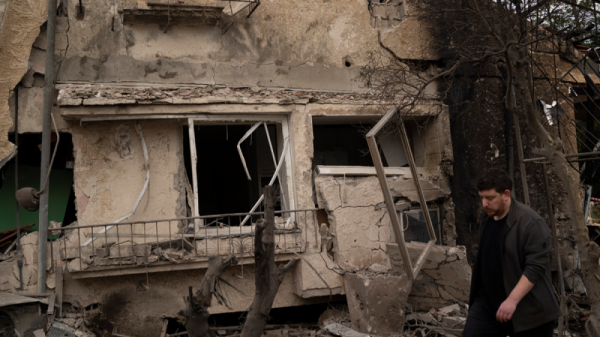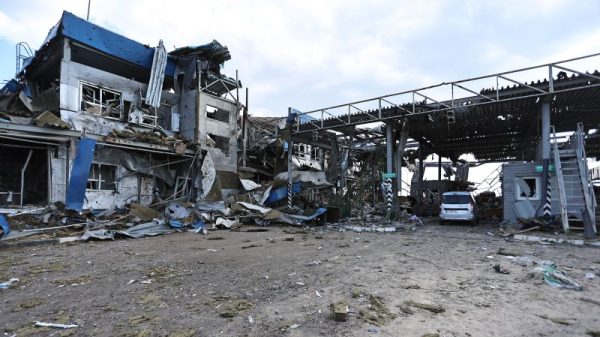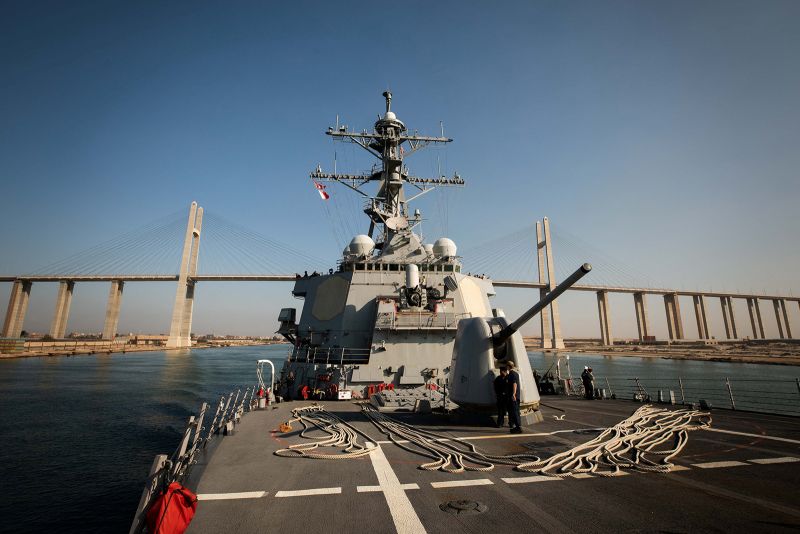US warships in the Red Sea have been battling a growing number of weapons fired by Houthi forces in Yemen over the past several weeks, including an incident on Saturday when a US destroyer shot down more than a dozen drones.
And US faceoffs with the Houthis, who say they are targeting commercial ships headed for Israel after its invasion of Gaza, could grow after Defense Secretary Lloyd Austin announced Monday a new US-led operation focusing on protecting merchant ships operating in the Red Sea and Gulf of Aden.
The US Navy has not said what weapon systems its ships are using against the Houthi attacks, but the experts said a US destroyer has a range of weapons systems at its disposal.
These include surface-to-air missiles, explosive shells from the destroyer’s 5-inch main gun and close-in weapons systems, the experts said. They also said US ships have electronic warfare capabilities that could sever the links between drones and their on-shore controllers.
Whatever systems US destroyer captains use, they face decisions on cost, inventory and effectiveness as the mission grows, the experts said.
“The drones are slower and can be hit with the cheaper missiles or even the ship’s gun. Faster missiles must be intercepted with more sophisticated interceptor missiles,” said John Bradford, senior fellow at the S. Rajaratman School of International Studies in Singapore.
Ship attacks in vital channel take global economic toll
Iran-backed Houthi forces have launched numerous attacks against US interests in the region, and Israel, since the October 7 Hamas attacks in Israel, as fears continue to ripple across the region that the Israel-Hamas war could widen.
The group has said any ship heading to Israel was a “legitimate target” as it puts pressure on Israel to stop its Gaza offensive. They have staged several drone and missile attacks on commercial shipping, and even tried landing commandos by helicopter on one vessel to hijack it.
The world’s biggest container shipping companies have paused transit through one of the world’s trade arteries, which experts say could snarl supply chains and drive up freight costs.
MSC, Maersk, CMA CGM and Hapag-Lloyd all said in recent days that they would avoid the Suez Canal over safety concerns. Oil giant BP followed suit, prompting oil and gas prices to surge on Monday.
US Navy’s main asset – the guided-missile destroyer
With the attacks, the US Navy has said it will come to the aid of commercial shipping that finds itself in trouble.
The main US asset involved in the Red Sea to counter the attacks on shipping is the Arleigh Burke-class guided-missile destroyer, like the USS Carney, which downed the 14 Houthi drones on Saturday. The missiles in its magazine include:
– The Standard Missile-6 (SM-6), an advanced weapon that can shoot down ballistic missiles high in the atmosphere, other lower trajectory missiles and target other ships with a range of up to 370 kilometers, according to the Missile Defense Project at the Center for Strategic and International Studies (CSIS). These cost more than $4 million each.
– The Standard Missile-2 (SM-2), less advanced than the SM-6 with a smaller range of 185 to 370 kilometers, depending on the version, according to the CSIS. They cost about $2.5 million each.
– The Evolved Sea Sparrow Missile (ESSM), designed to hit anti-ship cruise missiles and lower speed threats like drones or helicopters at a range of up to 50 kilometers, the CSIS says. Each one costs more than $1 million.
Experts think the US is using the SM-2 and/or ESSM missiles against the Houthi threats so far.
Pricey munitions and the cost-benefit ratio
But as they are facing drones that can be produced and deployed in large numbers for unit prices under $100,000, a prolonged campaign could eventually tax US resources, the experts say.
“These are advanced air intercept capabilities with an average cost of around $2 million – making the intercept of drones not … cost effective,” said Alessio Patalano, professor of war and strategy at King’s College in London.
Houthi forces are funded and trained by Iran, so they have resources for an extended fight, the experts point out.
It’s also a question of to what lengths the US wants to go to protect merchant shipping, the experts said.
A US destroyer’s Phalanx close-in weapons system – Gatling guns that can fire up to 4,500 rounds a minute – could handle drone or missile threats that get within a mile of the warship, said Carl Schuster, a former US Navy captain and a former director of operations at the US Pacific Command’s Joint Intelligence Center in Hawaii.
That’s a relatively low-cost defense. But if drones do get that close, it is the last line of defense and a miss could cost US lives.
“A single missile or single drone does not sink a US warship, but it can kill people and/or do damage that required the ship to withdraw for repairs in port,” Bradford said.
Defense of warships vs. protection of merchants
And the Phalanx system can’t protect merchant ships the US destroyer may be watching over, sailing miles away from the warship.
“To provide wide area air defense (as opposed to self-protection) vessels rely primarily on anti-air missiles,” said Sidharth Kaushal, research fellow for sea power at the Royal United Services Institute in London.
Kaushal said US anti-aircraft interceptor missiles on US warships are fired from vertical launch system (VLS) cells on the deck.
Each cell can contain a mix of armaments (exact numbers are classified), but the number aboard any one vessel is finite, Kaushal said.
And if the Houthis can deplete a ship’s inventories with successive attacks, the warship could find itself short on munitions to protect the merchant vessels it’s watching over, said Salvatore Mercogliano, a naval expert and professor at Campbell University in North Carolina.
“While the navies are well equipped to swat down what the Houthi are currently throwing, the fear is that the scope and scale increase and the escorts cannot keep up a level of defense to protect commercial shipping,” he said.
The Houthis have not yet tried a true drone swarm attack – similar to what Russia has deployed repeatedly in Ukraine – one that could involve dozens of incoming threats at one time, the experts said.
“A swarm could tax the capabilities of a single warship but more importantly, it could mean weapons get past them to hit commercial ships,” Mercogliano said.
US warships also face the question of how to replenish missile inventory in the region, he said.
“The only site to reload weapons is at Djibouti (a US base on the Horn of Africa) and that is close to the action,” he said.
US looks for allied help
Patalano said the US-led operation to expand the number of warships protecting merchant vessels will help defensive efforts.
Speaking at a virtual ministerial meeting on Tuesday addressing Red Sea maritime security with representatives of 42 other countries, Defense Secretary Austin said “these reckless Houthi attacks are a serious international problem… and they demand a firm international response.”
“These attacks threaten the free flow of commerce and endanger innocent mariners. They must stop,” he added.
A day earlier, Austin announced the establishment of Operation Prosperity Guardian in the Red Sea, a multinational operation that also includes the United Kingdom, Bahrain, Canada, France, Italy, Netherlands, Norway, Seychelles and Spain.
“It would seem that more ships (will be) in position to support each other, de facto expanding the range and volume of capabilities available in the area to deal with the challenge,” Patalano said.
Possible threats in an evolving battlespace
While increased allied cooperation could help, the experts said deployment of anti-ship cruise or ballistic missiles could present a new challenge.
Anti-ship cruise missiles “can come in low and penetrate a ship’s hull above the waterline. These are the type of weapons that sunk several British ships during the Falklands War and hit USS Stark (in the Persian Gulf) in 1987,” Mercogliano said.
Ballistic missiles could present an even greater danger, he said.
“The terminal velocity of the weapon and its payload could inflict serious damage” on a warship or commercial vessel, he said, and may need the best US interceptors, like the SM-6, to shoot it down.
Mercogliano said the battlespace is not static and the Houthis will have something to say about what they will deploy.
“The Houthi are watching and seeing how the navies are responding to these attacks,” he said.
And the experts say the US may at some point decide it has to go on offense.
“There is another course of action which is striking at the source. This would shift the emphasis from intercepting the capabilities once they’re in the air to strike them at the source to prevent their use in the first place,” Patalano said.
“Given a choice and capability, it is always cheaper to take out the archers than to intercept the arrows,” Schuster said.







































